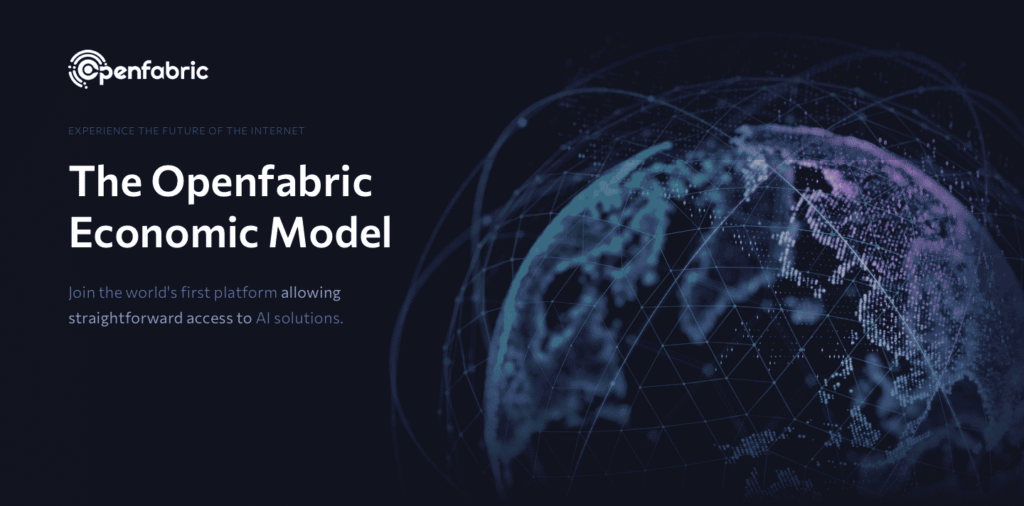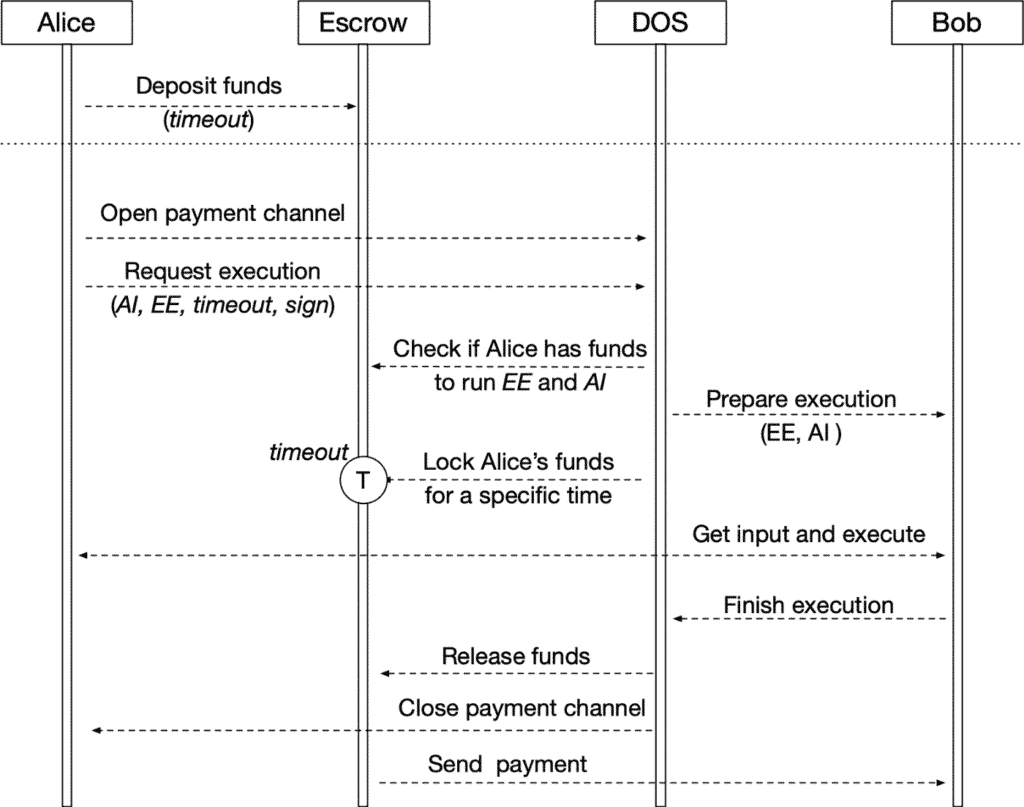
November 24, 2020 7 minutes read
The Openfabric Economic Model

The upcoming Fourth Industrial Revolution will be largely driven by the usage of Artificial Intelligence, a set of technologies that are now already beginning to permeate through most aspects of our daily lives. Ensuring the widespread adoption of AI technologies, as well as their continual and accelerated refinement, can only be accomplished with a strong economic model which incentivizes participants in the economy to channel their efforts in these directions. Rewarding participants for their contributions is a necessary condition for achieving unparalleled growth, but it alone is not sufficient. In order to achieve societal evolution at a truly exponential rate, the participants in the economy should also cooperate. Openfabric proposes a sustainable economic model which rewards participants in the ecosystem for their AI solutions, while also promoting collaboration.
This article covers the topic of the Openfabric economic model and its various aspects. To begin with, we will first present the interactions between the stakeholders and the platform; next, we will address the mechanism that ensures continual and rapid innovation; and finally, we will showcase the payment process on the Openfabric platform. So, let’s begin!
Economic interactions
As mentioned in the previous article, one of the platform’s key features is that it connects those who are seeking AI solutions and data to those who are able to provide those solutions and data. And that is precisely why the ecosystem is centered around four main actors and their interactions with the platform:
- The service consumers gain new insights by applying AI algorithms to datasets. They will obtain knowledge in exchange for paying the actors they interact with, either directly or indirectly (dataset, infrastructure and algorithm owners).
- The infrastructure providers lend their computing environment to those who are interested in running AI algorithms on the decentralized network. To make this process economically-rewarding and stimulate the providers in bringing more computational resources to the platform, they will be paid on a per-execution basis, in proportion to the number of resources used.
- The AI innovators provide useful implementations of AI solutions, which they will then deploy on the platform to be used by the other actors. The most appropriate way of stimulating AI advances is to pay for algorithms on a per-usage basis.
- The dataset providers are the actors who are in possession of valuable information that they would rather share with the community, instead of letting it remain siloed — and possibly forgotten. One way of motivating dataset providers to compile new collections is to pay them for their datasets on a per-download basis.
The Openfabric ecosystem acts as a medium through which value is created, serving as a free market in which evolutionary pressure stimulates the generation and monetization of novel AI algorithms. It also acts as an easy-to-use method for providing AI services to external users (companies or individuals) who simply want to solve their business use-cases.
However, it is the members of the ecosystem who are the major beneficiaries. At the moment, an untapped source of wealth lies dormant in code repositories all over the internet. AI developers create and use their algorithms, but mainly for showcasing purposes, due to the fact that there is currently no platform in which AI is properly monetized. The Openfabric project is here to fill in that gap. The situation is somewhat similar in the case of training datasets, as well: they are difficult to come by, and it is mostly only data scientists who have access to adequate data. Furthermore, at the moment, there is no real incentive to stimulate the creation of datasets; they are usually the byproducts of research endeavors.
Our platform can also represent a steady stream of income for those who have hardware resources that they would like to put to better use. Their contribution of raw computing power is a necessary element in bringing about the AI future. By offering a medium through which all the limitations exposed in the previous few paragraphs are addressed, Openfabric is a project of real economic impact.
Incentivization
The economic model is based primarily on the idea that intelligence should be held in high regard, as it is the trait that enables us to come up with groundbreaking solutions, and helps us to shape the society of the future. In this sense, Openfabric places major emphasis on community-wide intelligence by proposing an incentive mechanism which promotes collaboration amongst AI innovators. This mechanism allows AI innovators to combine algorithms — which have been tried and tested, and are popular with the community — in a tree-like structure, and to then innovate on top of this structure. Economy comes into play at this level, because the nodes (AI algorithms) have to be rewarded adequately each time that such trees are executed.

Each node in the tree (e.g. node u) has an associated cost, which consists of two components:
- A development cost, which is set by the AI innovator.
- A payout cost, which consists of a sum of fees required to pay the first-level children nodes (the q nodes in the picture above). Each term of this sum is weighted by a contribution function.
The contribution function is an indicator that determines the importance of an algorithm in the context of the current tree, taking into account an algorithm’s position in the tree (to decide how abstract/general it is), its community rating, and how frequently it is used on the platform.
After computing the total contribution for the entire tree, a reward function is responsible for partitioning the available funds by comparing individual contributions to the total one. The incentive mechanism we have just presented has the potential to generate a snowball effect that keeps AI Innovators focused in their search for new and general algorithms.
Payment flow
Now that the stakeholder’s economic interactions and the incentive mechanism have been discussed, it is time to concentrate on the actual payment flow. To do so, we now welcome to the stage two famous actors, and every cryptographer’s best pals: Alice and Bob. In the following scenario, Alice has decided on the AI algorithm, the dataset, and she has also picked some specifications for the hardware on which the AI algorithm is going to run. Bob will play the part of the infrastructure provider.

- The sequence begins with Alice making a deposit into an escrow smart contract. The funds will remain there for a specified time. If no one claims the funds during this period, she will be able to retrieve them.
- In the second step, Alice and the Decentralized Operating System set up a payment channel.
- Next, Alice signals that she would like to run an AI on a hardware platform (Execution Environment) that fulfills her specifications, all within a timeframe of her choice.
- The DOS checks whether Alice has enough funds deposited into the escrow to cover all of the expenses.
- If the checks are passed, the DOS chooses an infrastructure provider with an adequate execution environment — in this case, Bob, who is then notified to prepare the infrastructure. Subsequently, Alice’s funds are locked for the specified timeframe.
- At this point, Alice sends the dataset to Bob. After accomplishing this step, Bob’s computing system then begins executing the AI program on that particular dataset.
- Once the execution is finished, the DOS initiates the process of passing the funds to Bob. At this stage, Alice receives the results of the computation. And finally, the payment channel between the DOS and Alice is closed, and Bob receives the funds.
In this article, we have detailed three facets of the Openfabric Economic Model, namely the incentive towards collaboration, which guides the ecosystem to an accelerated rate of innovation, the stakeholder’s benefits, which result from their interaction with the network, and a simple payment flow between a service consumer and an infrastructure provider.
If you would like to see the math behind the incentive mechanism — or if you especially liked the sequence diagram from the payment flow section — please read our whitepaper.
This is the best way to understand the full complexity of the Openfabric project. On the website, you can also find links to our accounts on social media, so feel free to connect with us and start a discussion! And last but not least, be sure to also subscribe to our newsletter to find out the latest updates as they happen. Together, we can shape the AI landscape of tomorrow!

